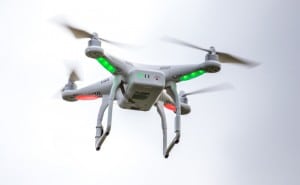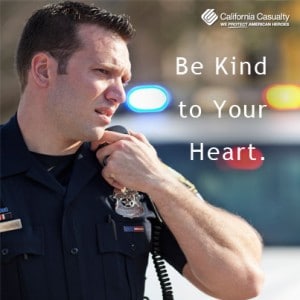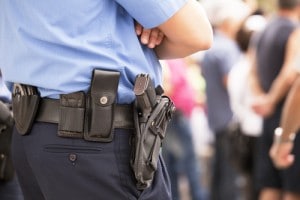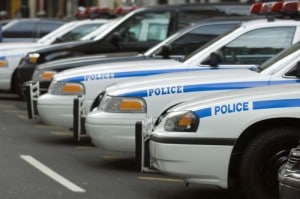by California Casualty | Peace Officers |
Is there any industry that technology hasn’t revolutionized in the past few decades? Over the last ten years in particular, changes in Internet technology, the development of new software, and the influx of mobile devices have led to significant shifts in law enforcement, for example.
Revolutionizing law enforcement
According to Sean Petty of LawOfficer.com, the last century has been marked by gradual implementation of new technologies and subtle changes in how officers handle their daily duties. However, Petty believes the next three decades will be much different.
In his words, “The law enforcement community, and the greater public safety community, are on the verge of changes in technology that will come not only at a blisteringly fast pace, but that will each be nothing short of transformational.”
New technologies
Though the future looks bright in terms of new technologies, the truth is that currently changes are happening on a grand scale. New technologies have been introduced in recent months that are already having noticeable effects on the industry.
In addition, more technologies are coming, right around the corner. Take a look at a few of these specific devices and the effects they’re having.
- Drone technology.
 Though not yet fully refined or regulated by many government agencies and municipal authorities, it’s pretty certain that drone technology will have a future in law enforcement. From providing real-time analysis of crimes to monitoring high-crime areas, drones will be able to give law enforcement officials more access and flexibility than ever before.
Though not yet fully refined or regulated by many government agencies and municipal authorities, it’s pretty certain that drone technology will have a future in law enforcement. From providing real-time analysis of crimes to monitoring high-crime areas, drones will be able to give law enforcement officials more access and flexibility than ever before.
- Social media. The power of social media has already exhibited itself in numerous cases and will continue to be a force into the future. Investigators are actually allowed to bypass traditional security mechanisms and gain access to a user’s Facebook or Twitter profile when they have reasonable doubt to believe it could provide useful evidence in a pending case or investigation.
- Body cameras. An increasing number of police officers across the country are beginning to wear body cameras, which are capable of recording their interactions with criminals and citizens. They are small, compact, and usually attach to the upper torso of the officer. While these cameras are constantly being refined, they have already proven helpful in a number of cases.
- Google Glass.
 While Google Glass has so far failed to gain much traction in the market, it may become a valuable technology for law enforcement agents if it ever takes off. This technology could furnish real-time information, facial recognition features, GPS directions, and more.
While Google Glass has so far failed to gain much traction in the market, it may become a valuable technology for law enforcement agents if it ever takes off. This technology could furnish real-time information, facial recognition features, GPS directions, and more.
- Less-lethal weaponry. Tasers and stun guns have been incredibly valuable for police officers over the past few decades, and new technologies could enhance weapons further in the future. Ideally, officers should have the ability to use less-lethal force whenever possible, and new developments may continue to make this an attainable goal.
- Biometrics.
 Instead of relying on messy ink pads and fingerprint cards, many law enforcement agencies now have the ability to perform retinal scans, record digital fingerprints, and store DNA data with the assistance of advanced biometrics technology. As these databases and software continue to improve, it will become even easier to track criminal activity.
Instead of relying on messy ink pads and fingerprint cards, many law enforcement agencies now have the ability to perform retinal scans, record digital fingerprints, and store DNA data with the assistance of advanced biometrics technology. As these databases and software continue to improve, it will become even easier to track criminal activity.
- Tablets and mobile devices. While the average person enjoys using a tablet or smartphone to watch YouTube videos and play games, police officers actually use these devices to record and access information on the go, which allows them to utilize their time more efficiently while on duty.
California Casualty insurance
At California Casualty, we have the utmost respect for the law enforcement officers that protect our communities. As a way of showing our appreciation for first responders, we offer protection and peace of mind through superior car insurance policies and special benefits.
For more information on the policies we offer, please contact us today!
by California Casualty | Firefighters, Health, Peace Officers |
*Updated April 2018
Whether you’re a firefighter, police officer, or paramedic, life as a first responder can be stressful and challenging. As a result of dangerous or hectic duties and long hours, many first responders are left with little time to care for themselves.
Does this sound familiar? If so, it’s important to start focusing on yourself a little more.
Tips for staying healthy and fit
It’s an admirable thing, to focus on the needs of others and care for strangers in challenging situations. However, there comes a point in time when you also need to think about yourself.
Try implementing any or all of the tips below into your daily routine to experience better overall health and improved fitness.

- Get enough sleep. First responders often suffer from any number of sleep problems because of drastic irregularities in their schedules. If you believe you suffer from a sleeping disorder or condition, it’s critical that you see a doctor and get the situation under control. While it may be difficult, you should shoot for seven to eight hours of sleep per night. This allows your body to recover and keeps you mentally prepared.

- Drink plenty of water. Your body thrives on hydration and needs adequate water intake to function properly. According to the Mayo Clinic, that means roughly 13 cups per day for men, and 9 cups a day for women. If you’re coming in under these marks, you’re probably not as energized or healthy as you could be.
- Maintain a balanced diet.A healthy, balanced diet is key to staying healthy and in shape. For optimal results, eliminate as many processed foods as possible and focus on fresh fruits, vegetables, and whole grains. You also want some lean protein in your diet, but too much can be a problem. Your muscles crave carbohydrates, and the more you can take in, the better prepared you’ll be for physically demanding situations.

- Stop smoking. If you’re a smoker, you have to quit. Period. You understand the risks associated with smoking, and your cardiovascular health can’t handle this horrible habit. Smoking is one of the worst things you can subject your body to, and you won’t be able to perform well unless you curb this addiction.
- Decrease alcohol intake.While you don’t necessarily have to give up alcohol altogether, you probably should decrease your intake. Avoid drinking alcohol right before bedtime, because this can disrupt your sleep cycles. If you enjoy alcoholic beverages, try to limit yourself to drinking only on off days … and doing so in moderation.
- Exercise on a regular basis.While you probably get plenty of hands-on action on the job, you also need to set aside regular time each day for a targeted fitness regimen. Focus on both strength and cardio training with high-intensity workouts. Plan major workouts for your off days while making sure to include short fitness routines in your work schedule.
- Discover ways to relieve stress.There’s no way around it: being a first responder is stressful. There will be days when it seems like it’s too much to handle. And while there’s no way to eliminate stress completely, you should work actively to reduce its effects on your life. Investigate constructive and safe ways to release stress, and learn to separate your duties from your personal life when possible.
- Regular health screenings. Finally, it’s important to get regular health screenings a couple of times per year to ensure your body is functioning properly. High blood pressure is known as “the silent killer” and should be monitored on a regular basis.
Insurance for first responders
At California Casualty, we offer premiere auto insurance for first responders. Whether you’re a firefighter, police officer, or paramedic, we take pride in offering reliable and convenient policies that fit your lifestyle and provide valuable peace of mind.
by California Casualty | Peace Officers |

Peace officers are taught to be tough, in control and looking out for the welfare of others. Keep in mind, though, the job also comes with a lot of stress that could be hard on the heart. While February is the month of love, it’s also Heart Month – a reminder that we need to take care of our hearts so we will be around to celebrate many more Valentine’s Days with our loved ones.
If you are in law enforcement, don’t think a heart attack can’t happen to you; working odd shifts, responding to incidents and crashes and subduing suspects all take a toll. Research by Harvard doctor Stefanos Kales found policing is one of the most stressful jobs in the United States and the risk of suffering a heart attack escalates by 70 percent during dangerous activities like:
- Altercations/suspect restraining
- Pursuits
- Physical training
- Rescue operations
Kales estimates that sudden cardiac deaths account for 10 percent of all on-duty U.S. police deaths. His conclusion: more needs to be done by law enforcement agencies to promote fitness and health programs to reduce officers’ risk of heart attacks.
Warning Signs
So what are the warning signs and risks factors? The Centers for Disease Control and Prevention says these are the three major risk factors for heart disease:
- High blood pressure
- High LDL cholesterol
- Smoking
These other medical conditions and lifestyle choices also put people at a higher risk:
- Diabetes
- Obesity and being over-weight
- Poor Diet
- Physical Inactivity
- Excessive alcohol use
Pay attention; here are the primary warning signs of a heart attack:
- Chest pain or discomfort
- Upper body pain or discomfort in the arms, back, neck, jaw or upper stomach
- Shortness of breath
- Nausea, lightheadedness or cold sweats
And women are not immune to heart disease. While the incidence of heart related death rates have declined steadily for men, rates for women have fallen at a slower rate.
Recommendations
An article in Officer.com discussed the risk of heart attack for law enforcement officers and offered these prevention tips:
- Quit smoking
- Maintain a healthy cholesterol level and know your number
- Control blood pressure
- Do regular exercise
- Get adequate sleep
- Maintain a healthy weight
- Improve your diet
- Manage stress
- Use aspirin therapy
- Reduce alcohol intake
Dr. Kales and his researchers also concluded that law enforcement agencies should:
- Conduct annual physicals
- Require regular physical fitness
- Ban smoking
We think your auto and home insurance shouldn’t add stress to your life. California Casualty has a long relationship with law enforcement groups across the nation providing quality insurance with exclusive benefits not available to the general public. Find out more and get a policy review today at 1.800.800.9410 or at www.calcas.com/peace-officer. While you’re at it, make sure to enter the California Casualty “Work Hard/Play Hard” contest at https://go.calcas.com/harley for the chance to win a customized Harley-Davidson or $25,000. The next winner will be announced in October.
Sources for this article:
https://www.heart.org/HEARTORG/
https://www.cdc.gov/heartdisease/facts.htm
https://www.nlm.nih.gov/medlineplus/news/fullstory_149525.html
https://www.utahpeoplespost.com/2014/11/police-officers-face-higher-risk-sudden-cardiac-death/
by California Casualty | Firefighters, Health, Peace Officers |
As the first people on the scene during accidents, emergencies, and crimes, first responders are susceptible to experiencing strong emotional and physical reactions to stress. From sadness and fear to anxiety and anger, stressful emotions experienced on the clock are easily taken home at the end of your shift. Without an ongoing commitment to living a healthy, stress-reducing lifestyle, debilitating disorders, like chronic depression and PTSD, can emerge. Whether you’re an EMT, firefighter or police officer it’s important to take proactive measures to protect yourself from the destruction stress can cause.
Stress Management Isn’t Just Important – It’s Urgent!
The combination of mental and physical effects of stress can become unbearable, particularly for first responders who need to remain focused and clear-headed at work. Compared to other professionals, first responders are often last to seek help for work-related stress. According to the International Journal of Emergency Mental Health, first responders experience extreme discrimination from peers, including derogatory remarks, labelling, and loss of social status, when attempting to seek help. To effectively manage stress as a first responder, the first step is to learn about the two basic forms of stress you are likely to experience: stress during an incident and stress after an incident
Underestimating the duration of stress and its effects on mental and physical health is one of the biggest mistakes made by emergency personnel. Before you can begin to manage stress, it’s necessary to understand what stress looks like during and after a traumatic event. Emergency medical professionals, firefighters and police officers experience the following:
- Stress during an incident. Between denial, sorrow, fear, and numbness, many feelings can overwhelm you during an incident. Increased irritability, inability to concentrate, and irrational thoughts, are psychological signs of stress taking hold. Physically, stress may induce rapid heart rate, nausea, and shortness of breath.
- Stress after an incident. After experiencing a traumatic event, many first responders report an inability to sleep well, recurring nightmares, distractibility, and an inability to regulate emotions. Family conflicts, isolation, and chronic mental or physical disorders can occur as a result of unmanaged stress.
Learning to recognize the symptoms and consequences of stress is the first step in stress management. The next step is to learn to reduce stress.
8 Tips to Help First Responders Reduce Stress

Both on and off the job, you have the power of choice. Choose to stay at the top of your game by engaging in these 8 stress-reducing activities:
- Take time off when needed. Regardless of their role, first responders are an exceptional group of individuals committed to helping others and preserving safety. This dedication, while admirable, can quickly lead to a feeling of being overworked and highly stressed. After a particularly traumatic incident on the job, take time off to regroup and reinvest in yourself.
- Find a hobby. Essential for personal development, hobbies are a safe, healthy, and fun way to shift focus away from stressors and toward relaxation. From gardening or playing cards to painting or joining a club, participating in activities outside the workplace adds balance and serenity to your life.
- Exercise regularly. Keep up with the physical demands of your profession while maintaining a healthy weight by exercising regularly. Research indicates that exercise increases the body’s level of endorphins, resulting in improved mood, decreased irritability, and an enhanced ability to concentrate. Choose a fun fitness routine, like boxing or group classes, to remain motivated to exercise.
- Eat healthy foods. Expecting an uninterrupted lunch break as a first responder may seem farfetched, but that isn’t an excuse to load up on carbs, fat, sugar, and salt. In addition to negatively affecting your overall health, consuming unhealthy, processed, or fast foods can lead to increased irritability, low energy, and poor concentration. Instead, drink plenty of water and eat balanced meals that include whole grains, lean protein, and vegetables.
- Practice meditation or yoga. To battle the effects of stress, engage in meditation or stress-relieving exercises, like yoga. By combining stretches, breathing exercises, and bodily poses, yoga helps relieve anxiety, depression, and stress. Meditation alone is shown to help alleviate feelings of anxiety and depression, as well as reduce pain. According to the National Center for Complementary and Alternative Medicine, meditation is a technique used by nearly 10% of adults in the U.S.
- Start a journal. Communicating your thoughts and feelings is crucial to overcoming the experience of trauma. Even if you’re not ready to speak with a counselor, keeping a journal about your experiences allows self-expression without threat of discrimination. Simply writing to yourself will not only help get certain events off your mind, but will also enhance your communication skills.
- Seek counseling. Individual counseling can work wonders for first responders, even if they have not recently experienced trauma. By actively participating in counseling, emergency professionals receive a source of ongoing emotional support while working to manage stress. Working with a therapist to establish and maintain a healthy lifestyle increases your ability to appropriately cope with stress.
- Attend a support group. Participation in social events in a supportive setting is crucial for first responders, as it helps form bonds between those recovering from work-related trauma. Meeting with others who have experienced similar events is both an affirming and reassuring activity. After joining support groups, first responders are able to expand their social networks, focus on healthy relationships, and overcome work-related trauma.
Taking one or more of the above steps will help relieve stress now and in the future. With first responders considered high risk for PTSD and depression, investing in your physical and mental health now is important for ensuring you have an enjoyable future.
The biggest obstacle to getting help is feeling confident when asking for help that the help is confidential. Here is a list of resources. Some are specific to Fire/EMS; some are specific to Law Enforcement. All are resources for confidential help.
American Foundation for Suicide Prevention – Resource for understanding warning signs of suicide and how to get help for yourself or someone else.
Centers for Disease Control and Prevention – Resources for individuals affected by a disaster – including first responders.
National Center for PTSD – Good resource for anyone who has experienced trauma.
National Institute of Mental Health – Good resource for a wide variety of mental health information.
National Suicide Prevention Lifeline – This is a hotline for anyone in crisis or to get help form someone in crisis. You do not need to be suicidal to call this line. They are there to listen and provide resources without judging. Afraid to call? Use the chat function from a computer or mobile device. Either way, you can remain anonymous!
Sites Specific to Fire/EMS:
All Hands Working – Organization dedicated to providing help to firefighters on and off duty.
Firefighter Behavioral Health Alliance – Non-profit organization developed to help educate firefighters and EMS about mental health on the job.
Helping Heroes – List of behavioral health resources specific to firefighters from National Fallen Firefighters Foundation.
Share the Load Support Program for Fire and EMS – Focusing on the mental well-being of firefighters and EMS.
Sites Specific to Law Enforcement:
Badge of Life – Site is specific to law enforcement and suicide prevention.
CopsAlive.com – Information, strategies and tools to help cops plan for happy, healthy and successful careers, relationships and lives.
Tears of a Cop – Site dedicated to stopping officer suicide and providing resources for PTSD.
Asking for help is the hardest thing to do! Sometimes even “heroes” need help. Please reach out if you or someone you know is struggling.
This article is furnished by California Casualty, providing auto and home insurance to educators, law enforcement officers, firefighters and nurses. Get a quote at 1.800.800.9410 or www.calcas.com.
by California Casualty | Peace Officers |

Keeping guns and ammunition secure can be a full-time job for any law enforcement professional, but proper storage options make this task easier. This article, the last in a three-part series, looks at six ways to secure the weapons in your station. You can read part 1 and part 2 to take a closer look at other necessary storage options for the modern law enforcement facility.
1. Properly Mounted Temporary Storage
Do your officers need a gun in the interrogation room or in common areas? No — and when situations are heated, having a gun out in the open can increase the chance of a problem. Installing temporary storage options, such as secure gun lockers, in these areas will help prevent unwanted discharges and the problems that they bring. These lockers keep guns secure (by requiring entry with a key) yet still accessible if the guns will be needed shortly.
2. Secure Weapons Rooms
Secure weapons rooms are the ultimate storage option for the modern law enforcement facility. With storage lockers or racks, this room gives the facility a one-stop place to store and retrieve weapons. A variety of organizational options keep firearms and ammunition accounted for, while a locked door ensures that they are only delivered to authorized personnel.
3. Shelving with Electronic Security
Weapon shelving is an excellent choice for storing guns in an accessible manner. But the modern law enforcement facility must be certain that items are stored securely, so only authorized personnel can access them. If the facility doesn’t have the space for a designated weapons room, electronic security that tethers the firearms to the shelf until accessed by the proper personnel is a good solution.
4. RFID Tracking Systems
In addition to providing security, RFID tracking systems built into storage systems can help facilities know who has checked out a particular weapon, making it easier to locate missing items and pinpoint who used a certain firearm in case of an investigation.
5. Universal Weapon Racks
These racks fill a need for secure weapons storage in facilities where a full weapons room is not needed. Universal weapon racks have locking doors that keep them secure when not in use. The racks can be adjusted to fit a variety of handguns, and can tilt up to 90 degrees in any direction without losing their hold on the guns or causing damage to equipment. This type of rack can be used in your facility, your transport vehicles or anywhere else that secure storage is needed.
6. Mobile Storage Solutions
Officers often need to bring their weapons into the field. Mobile storage solutions provide a secure way to do this. For single handguns, portable gun boxes are the best choice. Padded and locked, these boxes protect the firearm and store it safely.
When multiple firearms are needed in the field, mini universal weapons racks can help. Like their larger counterparts, these smaller versions keep firearms protected during transport, and can carry a larger number of firearms than gun boxes, which hold only one.
Whether you choose one or all of these options for your facility, ensure that your weapons are secure and accessible with proper storage.
Author Bio:
Denny Hammack is the President of Patterson Pope, a primary provider of storage opitions for businesses in the public safety industry. Hammack has over 25 years of experience in the storage and records management industry and has lead Patterson Pope to become one of the leading public safety storage solution providers in the industry.
by California Casualty | Peace Officers |

Setting up a police station can feel like an overwhelming task — from the weapons your team will use, to the desks they will sit at to write reports. The list of items you need to get started is quite extensive. As you are preparing a new station, don’t forget these seven crucial storage and organizational items that every station needs. This article is part 2 of a three-part series to help modern law enforcement facilities get as organized as possible. Read part 1 here.
1. Cabinetry
Office supplies, printer paper, protective equipment, extra uniforms — the list of items in a police station is practically endless. Attractive cabinetry keeps those items off the floor and off desks to make the station organized and tidy, while still allowing for accessibility. When setting up a police station, cabinetry will be essential in nearly every room, from the office areas to the common rooms.
2. Weapons Storage
Weapons storage is crucial, as it will provide safekeeping when weapons are not in use. Storage needs to be both accessible and protected. Those in charge of designing the facility need to consider temporary weapons storage options for common areas and interview rooms as well as the main weapons storage area. Portable weapons storage is also a necessity.
3. Evidence Lockers and Storage
Evidence lockers provide a safe place to temporarily store evidence before the lab can evaluate it. These lockers need to be secure so no one can tamper with the evidence, but accessible so officers can quickly deposit evidence before filing reports or booking suspects.
Once the evidence has been logged and analyzed, it needs a safe place to be stored. A wide range of static shelving options can hold items such as clothing and used ammunition (for use in court), or for record-keeping purposes.
4. Filing Systems
Every arrest and case brings pages of paperwork. While the paperwork side of law enforcement is neither glamorous nor exciting, it is crucial to ensuring that people are treated properly when facing arrest. Because of the amount of paperwork involved with law enforcement, logical and secure systematic filing systems are necessary to ensure that the paperwork is handled properly once it is collected.
5. Mail Center
Mail is another crucial yet sometimes tedious part of running a station. A well-organized mail center allows this aspect of the station to be minimally stressful. When mail has a set place to go and a set group of people responsible for getting it there, the rest of the station can function smoothly. Sort modules and consoles can make setting up a mail center easy.
6. Personal Storage Areas
When officers are on the job, where are they going to stash their belongings? Personal storage areas are crucial to a well-run station. Lockers make the ideal personal storage area, as they provide officers with a secure place for clothing, purses, wallets and other personal items while they are on the clock.
7. Desks
Each officer in your station needs a place of his/her own. Modular casework can serve as an ideal desk setup for personal workstations. These can easily be adjusted when your needs change or your station grows, but they provide officers with a place to file paperwork, perform computer searches, book suspects and store personal or professional gear when not in the field.
As you make the plans for your facility, make sure you plan for adequate storage. With these seven items in hand, you will be well prepared.
Author Bio:
Denny Hammack is the President of Patterson Pope. Patterson Pope is the primary provider of storage solutions for businesses in the public safety industry.
 Though not yet fully refined or regulated by many government agencies and municipal authorities, it’s pretty certain that drone technology will have a future in law enforcement. From providing real-time analysis of crimes to monitoring high-crime areas, drones will be able to give law enforcement officials more access and flexibility than ever before.
Though not yet fully refined or regulated by many government agencies and municipal authorities, it’s pretty certain that drone technology will have a future in law enforcement. From providing real-time analysis of crimes to monitoring high-crime areas, drones will be able to give law enforcement officials more access and flexibility than ever before. While Google Glass has so far failed to gain much traction in the market, it may become a valuable technology for law enforcement agents if it ever takes off. This technology could furnish real-time information, facial recognition features, GPS directions, and more.
While Google Glass has so far failed to gain much traction in the market, it may become a valuable technology for law enforcement agents if it ever takes off. This technology could furnish real-time information, facial recognition features, GPS directions, and more. Instead of relying on messy ink pads and fingerprint cards, many law enforcement agencies now have the ability to perform retinal scans, record digital fingerprints, and store DNA data with the assistance of advanced biometrics technology. As these databases and software continue to improve, it will become even easier to track criminal activity.
Instead of relying on messy ink pads and fingerprint cards, many law enforcement agencies now have the ability to perform retinal scans, record digital fingerprints, and store DNA data with the assistance of advanced biometrics technology. As these databases and software continue to improve, it will become even easier to track criminal activity.






